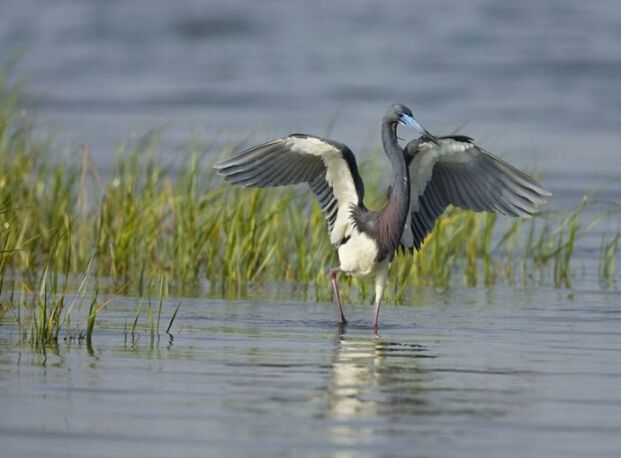Ardea insignis
IUCN
LCBasic Information
Scientific classification
- name:Ardea insignis
- Scientific Name:Ardea insignis,White-bellied Heron,Imperial Heron
- Outline:Wading birds
- Family:CiconiiformesArdeidae Heron
Vital signs
- length:127cm
- Weight:2.6kg
- lifetime:About 7-10 years
Feature
Timid and alert, flies away when seeing people
Distribution and Habitat
Distributed in Bhutan, India, and Myanmar; possibly extinct in Bangladesh; regionally extinct in Nepal.
The white-bellied heron inhabits the high plateaus, banks of mountain streams, and swamps in tropical and subtropical forests in the foothills of the Himalayas.
Appearance
The white-bellied heron has a thick straight beak, long and pointed; the neck is slender, the legs are also long, the lower part of the shin is bare and featherless, the whole body is dark gray, the top of the head is dark brown, there are long crest feathers on both sides of the head, gray; the front neck The base has long lanceolate gray-brown feathers, the nape and back are dark gray; the shoulders have long and lanceolate feathers gray, the tail and primary flight feathers are black gray; the lower chest, abdomen, flanks, axillary feathers and wing undercovers The feathers and undertail coverts are pure white, the leg coverts are white in front and gray behind.
The iris is yellow, the eyes, the exposed skin around the eyes and the base of the lower mouth are green, the slates on the upper and inner edges of the lower mouth are black, the underside of the tip of the lower mouth is ocher green, and the tarsometatarsus and claws are black.
The upper body of the young bird is dar
Details
White-bellied Heron is a large migratory wading bird with no subspecies.

White-bellied Heron is a migratory species. It often moves alone or in small groups of 4-5. It is timid and alert, and will fly away when it sees people. Although the flapping of its wings is slow during flight, the speed is very fast. The call is high and hoarse. It is active during the day or at dusk, feeding on aquatic organisms, including fish, shrimp, frogs and insects, as well as snakes, mollusks and small rodents. It often stands by the water or in shallow water, grabbing food quickly with its mouth.
The white-bellied heron usually nests in the forest swamps at the foot of the mountain or on tall trees on the banks of rivers and lakes. The breeding season is from April to June. The nest is made of dead branches, with a relatively large structure and a high nest position, usually placed high above tall trees. Each nest lays 3-4 eggs, which are blue-green and 72×50.8 mm in size. The male and female incubate the eggs together. The chicks are precocial.
The white-bellied heron is an endangered bird with a narrow distribution area and a small number. The species was first seen in southern Tibet and the Yarlung Zangbo River basin in China in May and July 1938, respectively, but has not been reported since then. It has not been seen in Nepal since the 21st century, is also rare in India and Bangladesh, and is uncommon in northern Myanmar.
The main threats to the White-bellied Heron are widespread forest and wetland loss, degradation, and human disturbance. The species is very sensitive to human disturbance, for example, a pair of disturbed breeding birds takes 48 hours to return to their breeding site (Mondal and Maheswaran 2014). Wetlands have been degraded due to pollution, rapid growth of aquatic plants, and overexploitation of resources. In key protected areas in northeastern India, Bhutan, and Myanmar, such as Namdapha National Park, increasing disturbance and habitat degradation, including human settlement, conversion of wetlands to agricultural land, harvesting of wetland resources, and increased poaching in the area, are believed to be the result. Natural forest fires destroyed the nests of the White-bellied Heron in Bhutan. In Bhutan, hydropower dam development and road construction have led to severe habitat degradation, affecting not only white-bellied egrets but also heron populations (Price and Goodman 2015). Rivers are busy transportation routes for humans, exacerbating the disturbance to this species.
Since the 1930s, the white-bellied egret has only been found three times in China in the past 80 years. In the 1930s, British experts in botany and zoology saw a tall white-bellied egret standing by the river in Milin County, Nyingchi City, Tibet. On July 8 of the same year, British experts again saw a white-bellied egret by the Yarlung Zangbo River near Pai Town, Milin County. However, the British experts' investigation more than 80 years ago was mainly to collect plant specimens. They neither collected white-bellied egret specimens nor took photos, so some scholars believe that the record "may be controversial."
On November 24, 2019, after identification by scientific researchers, a globally critically endangered species, the white-bellied egret, was found in Changning County, Baoshan City, Yunnan Province. After timely shelter and rescue by local authorities, it was released on the 22nd. Researchers have installed a satellite tracking recorder and a leg ring on the back of the white-bellied egret discovered this time, and will monitor it and formulate rescue measures accordingly. Listed in the "Red List of Endangered Species of the World Conservation Union" (IUCN) 2018 ver 3.1-Critically Endangered (CR).
Listed in the first level of China's "National Key Protected Wildlife List" (February 5, 2021).
Protect wild animals and stop eating game.
Maintaining ecological balance is everyone's responsibility!








